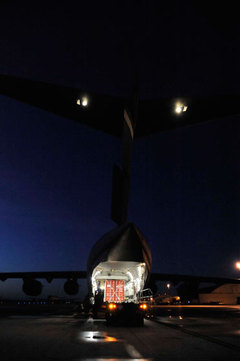Dépêches
NRL Positions Unique Elliptic-Orbit TacSat-4 Satellite for Launch
Dépèche transmise le 11 mars 2011 par Business Wire

NRL Positions Unique Elliptic-Orbit TacSat-4 Satellite for Launch
WASHINGTON--(BUSINESS WIRE)--Naval Research Laboratory spacecraft personnel make final preparations to ready the TacSat-4 spacecraft for a May 2011 launch. Transported March 1, to the Kodiak Alaska airport via an Air Force C-17 and trucked to the Alaska Aerospace Kodiak Launch Complex, the TacSat-4 satellite will be launched aboard an Orbital Sciences Minotaur-IV launch vehicle into a highly elliptical orbit (HEO) with an apogee of 12,050 kilometers.
“The ability to provide communications on the move without having to stop and point a SATCOM antenna was the most important user requirement and one which drove the design of the system”
TacSat-4 is a Navy-led joint mission managed by the NRL Naval Center for Space Technology. The mission of TacSat-4 is to experiment with new satellite communications (SATCOM) techniques, augment current SATCOM capabilities, and advance the development of Operationally Responsive Space (ORS) systems for improved responsiveness of space capabilities.
TacSat-4 augments current SATCOM by providing communications-on-the-move (COTM) for existing radios without requiring antenna pointing and providing 10 Ultra High Frequency (UHF) channels that can be used for any combination of communications, data ex-filtration, or Blue Force Tracking — a system that provides military commanders and forces with location information about friendly military forces.
TacSat-4 provides flexible up and down channel assignments, which increases the ability to operate in busy, and sometimes restrictive, UHF environments. The unique orbit of TacSat-4 also augments geosynchronous SATCOM by providing near global, but not continuous, coverage to include the high latitudes.
“The ability to provide communications on the move without having to stop and point a SATCOM antenna was the most important user requirement and one which drove the design of the system,” said Mike Hurley, section head, NRL Spacecraft Development.
The NRL Blossom Point Ground Station provides the command and control for TacSat-4 and maintains its user Virtual Mission Operations Center (VMOC) tasking system, allowing dynamic reallocation to different theaters worldwide and enabling rapid SATCOM augmentation when unexpected operations or natural events occur.
The Office of Naval Research (ONR) sponsored the development of the payload and funded the first year of operations. The Office of the Director of Defense Research and Engineering (DDR&E) funded the standardized spacecraft bus. The Operationally Responsive Space (ORS) Office funded the launch that will be performed by the Air Force Space and Missile Systems Center (SMC).
The spacecraft bus was built by NRL and Johns Hopkins University Applied Physics Laboratory (APL) to mature ORS bus standards developed by an Integrated (government and industry) System Engineering Team, the “ISET Team,” with active representation from AeroAstro, Air Force Research Laboratory, Johns Hopkins Laboratory APL, ATK Space, Ball Aerospace and Technologies, Boeing, Design Net Engineering, General Dynamics AIS, Microcosm, Microsat Systems Inc., Massachusetts Institute of Technology Lincoln Laboratory, Orbital Sciences, NRL, SMC, Space System Loral, and Raytheon.
The Naval Research Laboratory is the Department of the Navy's corporate laboratory. NRL conducts a broad program of scientific research, technology, and advanced development. The Laboratory, with a total complement of nearly 2,500 personnel, is located in southwest Washington, D.C., with other major sites at the Stennis Space Center, Miss., and Monterey, Calif.
Photos/Multimedia Gallery Available: http://www.businesswire.com/cgi-bin/mmg.cgi?eid=6644080&lang=en
- 06/06Crash d’un Morane-Saulnier 733 à proximité de la base aérienne de Rochefort
- 06/06 Les Flying Bulls feront le show dans les airs au Red Bull Motormania
- 06/06Meeting Cerny-La Ferté-Alais 2025 : programme des vols avec horaires pour le samedi
- 06/06 Radia présente le WindRunner pour la première fois en France au Salon du Bourget
- 06/06 Air Niugini divulgue une commande de deux nouveaux avions A220
- 05/06 Air Transat prolonge sa liaison Bordeaux - Montréal à l’hiver 2025-2026
- 05/06 Emirates et Air Mauritius renouvellent leur partenariat
- 05/06 Vietjet a commandé des Airbus A330neo supplémentaires
- 05/06 United Airlines inaugure une nouvelle liaison saisonnière sans escale entre Nice et Washington D.C.
- 05/06 easyJet inaugure des nouvelles liaisons vers l'Italie
- 04/06 Cathay Pacific relance sa liaison vers Adélaïde
- 04/06 Nesher Aviation commande des Tecnam P-Mentor
- 04/06 Airbus livre le premier A321XLR motorisé par Pratt & Whitney à Wizz Air
- 04/06 Finnair étoffe son programme hivernal
- 04/06 Le premier Bombardier Global 8000 de série effectue son vol inaugural
- 04/06 Le Groupe Qatar Airways annonce les meilleurs résultats financiers de son histoire
- 04/06 Corsair signe un partenariat avec Hertz
- 01/06Incident au sol d'un Spitfire à Biscarrosse
- 31/05Meeting Cerny-La Ferté-Alais 2025 : et si vous voliez en DC-3
- 31/05 Le deuxième prototype du Cessna Citation CJ4 Gen3 prend son envol avec succès







